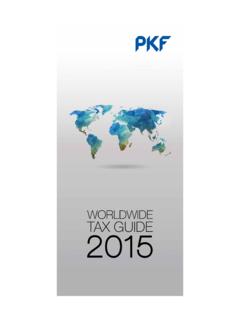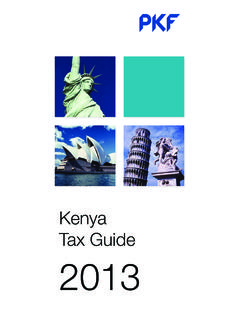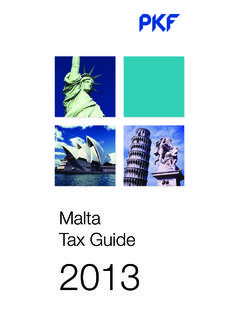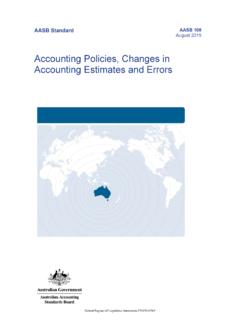Transcription of A C C O U N T I N G S U M M A R Y 2 0 1 7 - 04 IFRS 5 Non ...
1 ACCOUNTING SUMMARY 2017 - 04. IFRS 5 Non-current Assets held for Sale and Discontinued Operations Objective The objective of this IFRS is to specify the accounting for assets held for sale, and the presentation and disclosure of discontinued operations. In particular, the IFRS requires assets that meet the criteria to be classified as held for sale to be: (a) measured at the lower of carrying amount and fair value less costs to sell, and depreciation on such assets to cease; and (b) presented separately in the statement of financial position and the results of discontinued operations to be presented separately in the statement of comprehensive income.
2 Scope The classification and presentation requirements of this IFRS apply to all recognised non-current assets and to all disposal groups of an entity. The measurement requirements of this IFRS apply to all recognised non-current assets and disposal groups except for those assets listed below which shall continue to be measured in accordance with the Standard noted. This Standard does not apply to: (a) Deferred tax assets (IAS 12 Income Taxes). (b) Assets arising from employee benefits (IAS 19 Employee Benefits). (c) Financial assets within the scope of IAS 39 Financial Instruments: Recognition and Measurement.
3 (d) Non-current assets that are accounted for in accordance with the fair value model in IAS 40 Investment Property. (e) Non-current assets that are measured at fair value less costs to sell in accordance with IAS 41 Agriculture. (f) Contractual rights under insurance contracts as defined in IFRS 4 Insurance Contracts. Effective date An entity shall apply this IFRS for annual periods beginning on or after 1 January 2005. Earlier application is encouraged. Annual Improvements to IFRSs 2012 2014 Cycle, issued in September 2014, amended the methods of disposal by adding specific guidance for cases in which an entity reclassifies an asset from held for sale to held for distribution or vice versa and cases in which held-for-distribution accounting is discontinued.
4 An entity shall apply those amendments prospectively in accordance with IAS 8 Accounting Policies, Changes in Accounting Estimates and Errors to changes in a method of disposal that occur in annual periods beginning on or after 1 January 2016. Earlier application is permitted. Accounting summary 2017 - 04 1. Defined terms A discontinued operation is a component of an entity that either has been disposed of or is classified as held for sale and: (a) represents a separate major line of business or geographical area of operations.
5 (b) is part of a single coordinated plan to dispose of a separate major line of business or geographical area of operations; or (c) is a subsidiary acquired exclusively with a view to re-sale. A disposal group is a group of assets to be disposed of, by sale or otherwise, together as a group in a single transaction, and liabilities directly associated with those assets that will be transferred in the transaction. Classification of non-current assets (or disposal groups) as held for sale or as held for distribution to owners An entity shall classify a non-current asset (or disposal group) as held for sale if its carrying amount will be recovered principally through a sale transaction rather than through continuing use.
6 For this to be the case, the asset (or disposal group) must be available for immediate sale in its present condition subject only to terms that are usual and customary for sales of such assets (or disposal groups) and its sale must be highly probable. For the sale to be highly probable, the appropriate level of management must be committed to a plan to sell the asset (or disposal group), and an active programme to locate a buyer and complete the plan must have been initiated. Further, the asset (or disposal group) must be actively marketed for sale at a price that is reasonable in relation to its current fair value.
7 Events or circumstances may extend the period to complete the sale beyond one year. An extension of the period required to complete a sale does not preclude an asset (or disposal group) from being classified as held for sale if the delay is caused by events or circumstances beyond the entity's control and there is sufficient evidence that the entity remains committed to its plan to sell the asset (or disposal group). A non-current asset (or disposal group) is classified as held for distribution to owners when the entity is committed to distribute the asset (or disposal group) to the owners.
8 For this to be the case, the assets must be available for immediate distribution in their present condition and the distribution must be highly probable. For the distribution to be highly probable, actions to complete the distribution must have been initiated and should be expected to be completed within one year from the date of classification. Actions required to complete the distribution should indicate that it is unlikely that significant changes to the distribution will be made or that the distribution will be withdrawn.
9 The probability of shareholders' approval (if required in the jurisdiction) should be considered as part of the assessment of whether the distribution is highly probable. Non-current assets that are to be abandoned An entity shall not classify as held for sale a non-current asset (or disposal group) that is to be abandoned. This is because its carrying amount will be recovered principally through continuing use. However, if the disposal group to be abandoned meets the criteria of a discontinued operation, as defined, the entity shall present the results and cash flows of the disposal group as discontinued operations at the date on which it ceases to be used.
10 Accounting summary 2017 - 04 2. Non-current assets (or disposal groups) to be abandoned include non-current assets (or disposal groups) that are to be used to the end of their economic life and non-current assets (or disposal groups) that are to be closed rather than sold. An entity shall not account for a non-current asset that has been temporarily taken out of use as if it had been abandoned. Measurement of a non-current asset (or disposal group) classified as held for sale An entity shall measure a non-current asset (or An entity shall measure a non-current asset (or disposal disposal group) classified as held for sale at the lower group) classified as held for distribution to owners at of its carrying amount and fair value less costs to sell.












